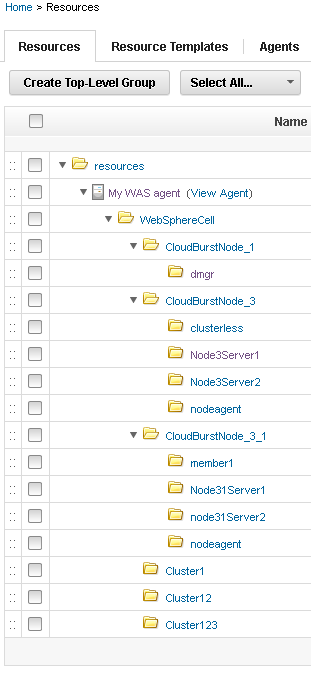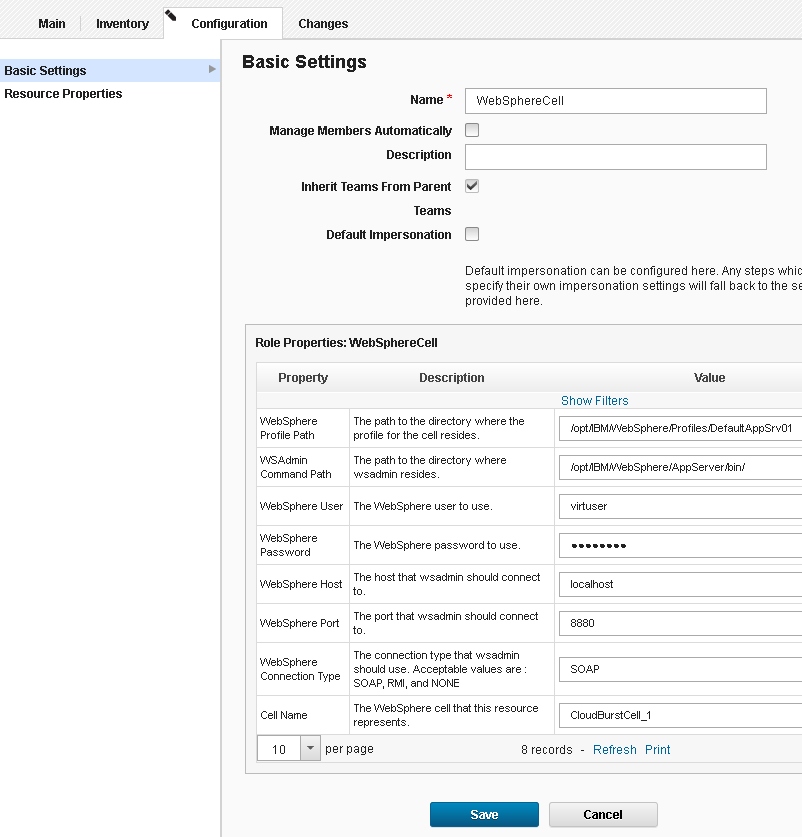Use the WebSphere® Application Server -
Deployment plug-in to import information about an IBM® WebSphere Application Server
system into a collection of resources. Typically, importing information by using the plug-in
takes less time than manually creating resources to match the IBM WebSphere Application Server.
Before you begin
- Install the WebSphere Application Server - Deploy plug-in. To download plug-ins, see the IBM UrbanCode Developer Center. Be sure to use the most recent
version of the plug-in.
- Create a top-level resource group to contain your agents. See Creating groups.
- Install an agent on the WebSphere Application Server system and add it as an agent resource under the top-level resource group.
Procedure
- On the IBM UrbanCode™ Deploy server,
click Resources to view the Resource
Tree tab.
- If the wsadmin file is in a different location than one of the
default locations, specify the file location as the value of the property
wsadmin.path on the agent resource.
The default location of the wsadmin file on
Linux is
/opt/IBM/WebSphere/AppServer/bin/wsadmin.sh. The default
locations on Windows are
C:\IBM\WebSphere\AppServer\bin\wsadmin.bat and
C:\Program Files\IBM\WebSphere\AppServer\bin\wsadmin.bat.
- If you are using WebSphere Application Server version 6.1 or later, but prior to version 7, set the
websphere.profilePath parameter on the resource that contains the
agent resource:
- On the WebSphere Application Server system, find the location of the file portdef.props.
- On the IBM UrbanCode Deploy server, on the resource that contains the agent resource, set the property
websphere.profilePath to the location of the
portdef.props file.
- Next to the top-level group, click Actions and
then click Add Agent.
- In the Create Resource window,
select the agent and then click Save. The new agent resource is displayed in the resource tree.
Eventually, another resource is displayed under the agent resource.
This resource is named WebSphereCell and represents
the WebSphere Application Server cell.
You might need to click Refresh to see the
cell resource, and it can take several minutes for the cell resource
to be displayed.
- Click the WebSphere Application Server cell
resource and then click . This
resource has the WebSphereCell role, which includes
several properties that are related to the cell.
- In the section that is labeled Role
Properties for the WebSphereCell role,
specify the connection information for the cell, including the locations
of the profile and wsadmin file and the user
name and password for the WebSphere Application Server system,
as in the following figure:
- Click Save.
- On the Resources tab, next to the cell resource, click
Actions and then click Configure using WebSphere Topology
Discovery. The discovery step runs. This step might take several minutes. A log is displayed to
show progress.
- When the discovery process completes, close the log window, and then refresh the
resource tree.
Results
Resources that represent the
WebSphere Application Server
components are displayed in the resource tree. These new resources appear under the agent
resource that you used to import the
WebSphere Application Server
components. Each node, cluster, and server has a matching resource. The following figure shows
resources that represent a
WebSphere Application Server
system with three nodes:
What to do next
Now you can add these resources to an environment by opening
the
Resources tab for the environment and clicking
Add
Base Resources.

